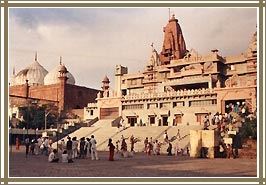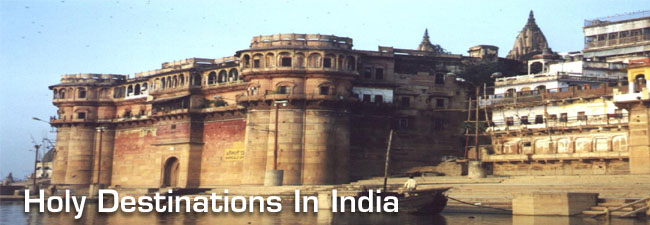 Mathura
Mathura
Clothing Language Temples In Mathura Fairs & Festival
Excursion
The city of Mathura, in Uttar Pradesh, the nucleus of Brajbhoomi,
is located at a distance of 145 km southeast of Delhi and 58
km northwest of Agra. Covering an area of about 3,800 sq. km,
today, Brajbhoomi can be divided into two distinct units - the
eastern part in the trans-Yamuna tract with places like Gokul,
Mahavan, Baldeo, Mat and Bajna and the western side of the Yamuna
covering the Mathura region that encompasses Vrindavan, Govardhan,
Kusum Sarovar, Barsana and Nandgaon.
Area 3780 sq. km. (Mathura District)
Season Max (Average) Min (Average)
Summer 48 C 22 C
Winter 26 C 6 C
Clothing Summer Cottons
Winter Light Woollens
Language Hindi, English and Brajbhasha
Access :
Air : Nearest airport is Kheria (Agra), 62
km, also Delhi Airport 155 km.
Rail : Mathura is on the main lines of the
Central and Western Railways and is connected with all the important
cities of the state and country such as Delhi, Agra, Mumbai,
Jaipur, Gwalior, Kolkata, Hyderabad, Chennai, Lucknow, etc.
Road : Mathura is connected to all the major
cities, either historical or religious, via the National Highways.
It is linked by the regular state bus services of Uttar Pradesh,
Madhya Pradesh, Rajasthan and Haryana.
Local Transport :
Private buses, tempos, rickshaws, cycle rickshaws, taxis and
tongas are also available.
Temples In Mathura
Krishna Balrama Mandir
This beautiful temple was established in 1975 by His Divine
Grace A.c. Bhaktivedanta Swami Prabhupada, founder-acharya of
the International Society for Krishna Consciousness (ISKON)
and has now become Vrindavan's most popular temple and has one
of the highest standards of Deity worship and cleanliness. Hare
Krishna devotees from around the world can be seen here throughout
they year, bringing a truly international flavour to this ancient
holy city.
Kalya Ghata (Kaliya-Hrada)
Here, Lord Krishna jumped from a big Kadamba tree into the
Yamuna River, in order to chastise the ?Kaliya? serpent who
was poisoning the waters of the river, in order to chastise
the ?Kaliya? serpent who was poisoning the waters of the river.
The kadamba tree that Krishna climbed is still here, even though
the Yamuna does not flow here anymore, except during the rainy
season when the river floods.
Radha Madana-Mohana Temple
This famous temple was established by Srila Sanatana Gosvami
and was the first temple to be built in Vrindavana, which at
that time was just a forest. The original Deity of Madana-mohana
was taken to Karauli in Rajasthan for safety during the attack
on Vrindavana by the soldiers of the fanatical Muslim Emperor,
Aurangzeb.
Jaipur Temple
This temple was built by the Maharaja of Jaipur, Sawai Madhav,
in 1917 after thirty years of hard labour. It is one of Vrindavan's
most opulent and grandiose temples. The fine hand carved sandstone
is of unparalleled workmanship, the huge pillars that hold up
the roof are each carved from one solid rock, and the intricately
fashioned marble on the alter is reminiscent of the Mughal period.
The Maharaja financed the railway line that connects Vrindavana
with Mathura, just for the purpose of hauling the huge pieces
of sandstone used in the temple construction. The Deities worshiped
here are Sri Sri Radha-Madhava, Ananda-bihari and Hansa-gopala.
Banke-Bihari Temple
Banke-bihari means Krishna, the Supreme Enjoyer. This is one
of Vrindavana's most popular temples and famous all over India,
it was built in 1864. Swami Haridasa discovered the Deity of
Banke-bihari in Nidhuvana. A contemporary of the six Gosvamis,
Swami Haridasa known for his devotional bhajanas, was the guru
of the famous musician Tansen.
Radha Vallabha Temple
Another very popular temple of Vrindavana whih was founded
by Hit Harivamsa Gosvami, who started the Radha Vallabha sect
emphasizing devotion to Radharani. In this temple, there is
no deity of Radharani, but a crown has been placed next to Krishna
to signify Her presence. The Muslims destroyed the original
temple of Radha Vallabha in 1670 and a new temple was built
at the side of the old one.
Seva Kunja
This is the sacred place of the rasa dance and also where Lord
Krishna offered service to Radharani by decorating Her hair
with flowers, as well as massaging and painting Her lotus feet.
Radha and Krishna would sometimes spend the night here, dancing
with the gopis and enjoying various transcendental pastimes.
There is also a small temple dedicated to Radha and Krishna's
pastimes called Rang Mahal. Near the entrance to this garden
is a kunda created by Lord Krishna. He pushed His foot into
the ground just to please Lalita devi when she was feeling thirsty
and wanted to drink water.
Radha Damodara Temple
This is one of the most important temples in Vrindavana. The
original Deity was hand carved by Rupa Gosvami and given as
a gift to his beloved disciple, Jiva Gosvami, who later built
a temple here. The Deity now being worshipped is the pratibhu-murti
(replica) and is considered no different from the original Deity.
Formerly this spot was in the middle of Seva-kunja and it was
the bhajana place of Rupa Gosvami. One can have darsana of the
sacred govardhana-sila by asking the pujari and giving a small
donation.
Radharamana Temple
This is the famous temple of Gopala Bhatta Gosvami. Radharamana
means "one who gives pleasure to Radha", and is one
of the many names of Lord Krishna. The seva puja of Radharamana
was established in 1542, after the Deity self-manifested from
a saligram-sila. Also kept in this temple is the wooden sitting
place (hoki) and shawl (chaddar) or Lord Chaitanya that he gave
as a gift to Gopala Bhatta Gosvami. There is no deity of Radharani
in this temple, but a crown is kept next to Krishna signifying
Her presence
Jugal Kishore Temple
This is one of the oldest temple of Vrindavana and was completed
in 1627. After Emperor Akbar's visit to Vridavana in the year
1570, he gave permission for four temples to be built by the
Gaudya Vaisnavas, which were Madana-mohana, Govindaji, Gopinatha
and Jugal Kisore. It is sometimes called the Kesi ghata temple,
as it is located next to this ghat
Kesi Ghata
This is the place where Lord Krishna killed the Kesi demon
who appeared in the form of a gigantic horse and then took His
bath in this very same ghata. This is also very famous bathing
place in Vrindavana. An arati to Yamuna Devi is held here every
evening.
Rangji Temple
This South Indian style temple was built by the wealthy Seth
family of Mathura in the year 1851, and is dedicated to Lord
Sri Ranganatha or Rangaji - a form of Lord Vishnu lying down
on the Sesa Naga (celestial serpent). This temple has a traditional
South Indian gopuram (gateway) and is surrounded by high walls.
It is one of Vrindavana's largest temples. Once a year a grand
car festival (Ratha Yatra) is held known as Brahmotsava, during
the month of Chait (March - April), this festival lasts for
10 days.
Dwarkadish Temple
The Dwarkadish Temple, built in 1814, is a popular temple in
the center of town. This is the most visited temple in the center
of town. This is the most visited temple in Mathura. Followers
of Vallabhacarya manage this temple. Once you enter this temple
from the street, it is fairly interesting architecturally and
there is a lot of activity inside. It is located in the eastern
part of Mathura, not far from the Yamuna River.
Fairs & Festival
Unique Attractions of Mathura - Holi
Holi is celebrated on the full moon day in the month of Phalguna
(Feb-March). Holi in Braja is celebrated for several days, at
different places around Braja, before the actual day of Holi.
People throw colored powdered dye and colored water on each
other. This is joyfully celebrated in Braja, especially at Varsana,
Nandagram and Dauji. In Varsana the festival includes colorful
processions with music, song, dance, and some boisterous scenes
around the temples. If you go to these festivals you should
expect to be totally covered in dye and never to be able to
use the clothes that you are wearing again, at least until next
year's festival. This is celebrated at the same time as Gaura
Purnima.
Varsana Groups of visitors go around in small and large groups
here. In the afternoon gopas (men) from Nandagram come to Varsana
and play Holi with the local gopis (women) of Varsana. The women
hit the men hard with 2 ?m (7ft) long bamboo staffs. The men
have shields, which they protect themselves with. During this
time local songs are sung. This festival is celebrated on the
ninth day of the month of Phalguna (Feb-March).
Nandagram The day after the Holi festival at Varsana, Holi
is celebrated in Nandagram. The gopas (men) from Varsana come
to Nandagram to play Holi with the gopis (women) there. The
flag of the Larily Lal Temple in Varsana is carried in an elaborate
procession to Nandagram. At this time the residents of Nandagram
attempt to capture the flag, but their attempts are foiled.
After this, women play Holi with bamboo staffs. This festival
is celebrated on the tenth day (dasami) of the month of Phalguna
(Feb-March).
On the full moon night in Feb/March a huge bon-fire is burned.
One of the local priests walks through the fire unscathed. One
story about Holi is that Prahlada Maharaja refused to worship
his father and wanted to worship his father's enemy, Lord Vishnu
instead. His father's sister Holika, who was immune to being
burned, sat with the boy in a big fire. Prahlada's devotion
was so great that Holika was burnt to death and Prahlada was
unharmed. The Holi festival a re-enacts this event.
Excursion Agra
Once the capital of the Mughals and the city of the Taj Mahal,
Agra is just 50 km from Mathura. Emperor Shah Jahan built The
Taj Mahal, the in memory of his wife Mumtaz Mahal, a symphony
in white marble, a tribute to eternal love.
Fathepur Sikri (60 Km from mathura)
The Emperor Akbar built the wonderful city of Fatehpur Sikri.
The marvellously preserved fort, palaces and the tomb of Salim
Chishti with its delicate lacy marble screens are worth seeing.
Deeg (Rajasthan)
An eighteenth century stronghold of the Jat rajas with its
picturesquely contrived garden-cum-water palaces, Deeg is a
popular tourist rendezvous today. Located at a distance of 11
km from Mathura, Deeg is easily approachable by road.
The fairy-tale palaces of Deeg are set at the edge of reservoirs
of water. A central ornamental garden with water bodies, canals,
and fountains, ordered lawns, beautiful trees and pavilions
is a charmingly green retreat. The principal palaces include
the Keshav Bhavan, the Gopal Bhavan, the Sawan and Bhadon pavilions
with their attractive curving roofs.
